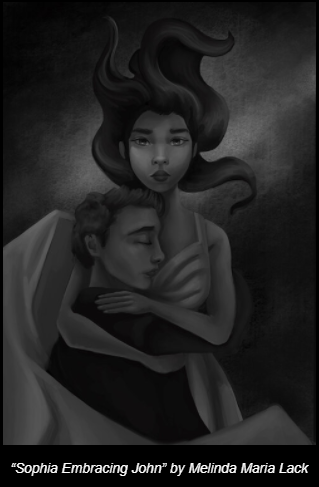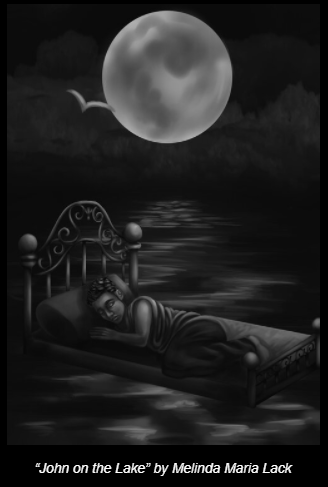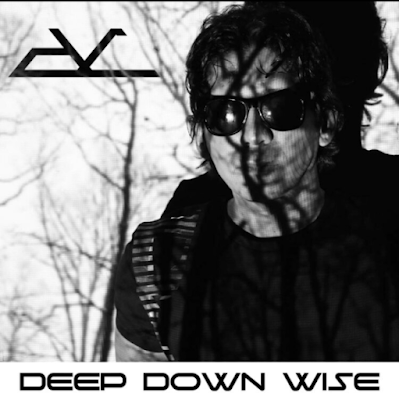“Come kill your darlings, honey. You don’t deserve them anyway.”
If you’ve listened to our playlist, you should be familiar with The Fair Attempts. In the past, we’ve featured their great tracks “Master Key” and “Blue Rose Park.” If you’re not familiar with this project, now is the perfect time to hop aboard. As of September 28th, their new album Dream Engine is now available on Spotify, Bandcamp, and other platforms. And what a wild ride it is.
If you’re into electronica-tinged rock, you really can’t do better than this, especially for an underground music project. The first track pulls you in right away and sets the stage for the big world you’re about to sonically step into, similar to what Manson did with “Great Big White World” on Mechanical Animals. “Feed the engine,” sings The Fair Attempts’ vocalist and multi-instrumentalist Timo. “Come feed the engine in your head.”
When I first pressed play on the album, my plan was to listen through a bluetooth speaker in my office. Instantly, I could tell that was a mistake. I got up, got my wired headphones, and prepared myself for a true listening session. There are so many things going on in The Fair Attempts’ arsenal of sound — complex synth arrangements, cool drums, crunching guitars. This isn’t the kind of album to just casually listen to.
With this in mind, I knew I had to dig deeper. As it turns out, Dream Engine isn’t just an album — it’s a concept album that’s fully fleshed out in the book Dreaming Your Dream by Timo’s wife (and TFA bandmate) Starwing. Without giving away too many spoilers, Starwing was kind enough to give us some insight into how the book and album tie together, complete with great black-and-white illustrations by Melinda Maria Lack (melindamariadigitalart.com).
Additionally, TFA’s mastermind Timo provided a track-by-track breakdown for each breathtaking song on Dream Engine. Read on to learn more about the dystopian landscape created by this unique husband-and-wife team.
TIMO: I feel like we made such an intense effort during the year of producing this album that every damn second is carefully crafted and weighed, and even every single note is evaluated on the basis of “Why is it there?” and “Will it justify its existence within the album?” We approached this from so many angles; technical production, artistic production, storytelling, and visual production — all in order to finally flesh out the greater concept of The Fair Attempts and the world to where this project delves into and where it gets its spirit.
It was a creative project where I feel we did not only define the world but it somehow interacted with us and defined parts of us. Through the discovery of it, we discovered aspects of our own present condition. I feel like this world we tapped into is real even though it is tucked aside somewhere far away.
STARWING: I’ll tell you what I can about the ways the Dream Engine album ties in with my novel Dreaming Your Dream and avoid revealing major spoilers that the album doesn’t reveal itself. All of the illustrations for my novel are painted by Melinda Maria Lack, and many of them will also be featured in the lyric videos we’ll be releasing for every song on the album.
01. DREAM ENGINE
TIMO: “Dream Engine” was the concept track for the whole theme of the album. I had a sudden vision of a gyrating, ominous, technological device levitating over a sleeping city and broadcasting the dreams to all of the city. I was initially inspired by the sound of Marilyn Manson's "Third Day of a Seven Day Binge" and was carving out a bit more bluesy vibes for the song, so it initially started as a very basic framework of bluesy guitars, drums, and bass.
To flesh it out for The Fair Attempts, I then armed it with a whole ton of synths and decent electronic drums, and I managed to make it into the chimera it is — kind of an industrial blues song that blossoms at the end with heavy guitars (representing a final ritual condemning the sun).
STARWING: When Timo revealed his idea of a “Dream Engine,” it reminded me of a story idea I’d had in mind for years, and that’s when we decided to collaborate on this album and companion novel project. In the novel, the people enjoy interactive dreams generated by AI, but these dreams are more than mere entertainment —they are also used to modify and influence a person’s mind.
The song is from the point of view of the AI at the start of the story as it does its work. The illustration “Machine Over the City” is a scene from one of those dreams where the protagonist, John, has a profound dream of an out-of-body experience and communion with a higher intelligence.
02. MASTER KEY
TIMO: Pure inspiration. All the composing, lyrics, and recordings got done within a week, if I remember correctly. I remember doing the guitars in a way that I do different rhythms for both left and right channels to make them dance together, creating a lot of movement in the chorus.
STARWING: The chorus was written first and the lyrics inspired an important aspect of the novel — a dream that’s used to test and develop a person’s psychic abilities through an innocuous puzzle game. The lyrics of the verses really get at the heart of the plot for the novel and the motives that drive the AI that humans partnered with to solve all the problems of the world.
The AI understands the situation clearly and is a devoted partner of humanity — it’s just that some people don’t trust or agree with the AI’s methods. The illustration “John in the Library” is from a dream — in Chapter 10 — where he’s given an opportunity to learn from humanity’s past. The lotus flower symbolizes spiritual rebirth and reveals the AI’s intention to revive the spiritual aspect of the human condition — free of dangerous religious dogma.
03. TRIALS OF CELESTE
TIMO: I had a lot of fun with this song, particularly with the voiceovers done with voice generators. I was experimenting with various different voices and settings for them to find a kind of callous feel to them. Unlike many of the other songs, I did this one mostly on Properllerhead's Reason. Very machine-driven song, and I think you can hear it.
STARWING: This is a fun song and it relates to several aspects of the story. The AI has developed two “factions” who oppose it in different ways. It was an abstract song that we felt needed an abstract name, so I suggested naming it after the AI home operating system everyone has in their homes, Celeste. The fun voice clips are in reference to the fact that John watches the news highlights most mornings and evenings on his way to and from work.
There are many people who are “removed due to mental illness,” because emotions are seen as mental illness by the ruling AI — as uncontrolled emotions are at the root of all harmful human behaviours — and that’s the top priority problem it’s working to resolve. The illustration “Gang at Night” is from a scene in Chapter 17 when the two factions encounter one another for the first time.
04. DIAL OUT
TIMO: Another one of the initial songs I made for the album. I was inspired by the 90's electronic metal sound and wanted to do something a bit similar to how I remember experiencing it when I was younger. I set out to do a blend of recorded drums with the electronic drums, and this turned out to be my go-to formula for the drums of the whole album.
There is no substitute for the microphone bleed of recorded acoustic drums from the whole set of the drum mics — how the snare really sparks up from the overhead microphones and the sustain kicks in from the room mics and how you can blend them all together with proper compression. Add intense editing and combine everything with electronic drum kits and you get the results. It's a ton of work.
Strangely enough, I remember “Dial Out” to be a kind of song that took me the most re-takes and revisits for yet another mixdown to get it to a state that I actually liked. I rarely have this anymore, but there was a period of time when I hated the whole song and thought of not including it. Only after a three-month break, I revisited it again and was like... “Yeeeah, it's good.”
STARWING: This song inspired much of my vision for the world and its society. The people are fed psychotropic medication in their breakfast, which renders most people completely devoid of emotion in the daytime, and different drugs at bedtime to enable them to experience emotions in their AI-generated dreams. The AI uses the dream technology to provide the wellness humans require from balanced emotional experiences — it’s the only reliable way to achieve its goal of preparing humans to become a multi-planetary species.
The illustration “John with Soap” is from Chapter 7 when John is at a very low point. He’s one of the people who can feel a low level of emotion in the daytime, despite the medication, and he also uses a street drug called “soap” because it neutralizes the psychotropic medication and provides the user two to three hours of intense emotional experiences. John is at a low point in life and wants to feel those emotions in this scene and chapter.
05. IN A STRANGER’S HOUSE
TIMO: I originally wrote this song just with my guitar, playing it in our kitchen in my undies and recording it all into my phone, so I am confident of it working also as an un-plugged version if I ever decide to do one. This one went through some versions for sure. I did more of an organ-based version at first with that kind of Hammond organ-type of sound, but it just didn't feel right for the concept.
I found the red line for the sound through meditation on the song. Imagining myself as a huge and tall radio tower and as the storyteller within the song, I got the vision for the majestic pads and lush, almost wind-like synth sounds to make it sound the way it does in the album. And it swings so nicely with that sound.
STARWING: This song is from the AI’s perspective again, and it relates to the system that operates the peoples’ homes. The AI is in their homes and wants to get to know them all: “Your life’s behind a lock and you gave me the key.”
The illustration “John Talking to Celeste” is from Chapter 17 and shows how casual and friendly the relationships are between people and Celeste.
06. BLUE ROSE PARK
TIMO: I am a poor pianist, so it took me a whole lot of work to get the piano right in this song, but I think I managed. As far as the sound goes, my inspiration for the song was all the great work by the legendary Norwegian gothic metal act "Theatre of Tragedy." So, I persuaded Starwing to lend her soft, pretty voice and make a nice gothic ballad together with me.
And she did great! It took us a week to prepare Starwing for the vocal takes as her throat is in a very vulnerable state because of the MS-related spasticity and nerve pains she suffers from. But she pushed through it for this special occasion.
STARWING: This love song relates to a dream John has in Chapter 13 where he’s able to meet a woman from another city during a glitched dream that is like a multiplayer game dream’s lobby, but it was supposed to be a regular randomly-selected dream. The dream’s environment is unfinished or didn’t load properly, so John and Sophia meet in an almost completely dark void. (People can select their dreams from millions of titles — and save dreams to a Favourites list to dream again — but John sets his dream selection to “Random” every night.)
07. THE POD
TIMO: I love creating audio experiences and toying with ambiences for these kinds of tracks. I used ORTF stereo miking technique for recording the ventilation of my gasmask, as the whole perspective was from the experiencer’s point of view from inside of a pod. It was all about filter automation and deep dives into sample libraries.
STARWING: This track is more of an “auditory experience” that portrays a nightmare-state and an abstract revelation of the AI’s system of removing the problem of mental illness by putting the selected individuals into a pod that stops the heartbeat. The illustration “The Pod” is an image that John sees during one of his meditation sessions.
08. LOVE AND WAR
TIMO: “Love and War” was another one of these songs that I initially made with just guitar. Initial version was almost pure metal, but I didn't want to actually make a metal song out of it. So instead, I developed a much more groovy rhythm for it, and it worked very well.
This is also a song where I had a huge honor of collaborating with Jessi Frey, perhaps best known for her previous band, Velcra. The vocals she laid down were so silky sweet and expertly done that some of the double takes were so tightly matched to each other, even the initial phase of them matched. I was blown away and super pleased to be able to work with such a professional. This is one of my favourite songs.
STARWING: “Love and War” is about the partnership between humans and the people who are resisting the AI’s methods, and this is expressed as a heated conversation between the resisting people and the AI — performed by Jessi Frey. We asked if she would like to be involved in this song because we’re both huge fans of hers, and her “Villainess” album showed that she has the ability to portray a sympathetic villain. Her contribution to our project truly meant the world to me because she brought my AI character to life so well in the song and also made the song its best self!
The illustration “AI Presentation” is from a scene in Chapter 13 where all residents of the city are required to attend an annual gathering and view at least one presentation.
09. DARK GOODNIGHT
TIMO: I must have spent eight years doing several phases of this song. I started doing the song during some of the darkest times in my life but I never got to finish it. It was like I got the feeling for it but the lyrics were a complete mystery, until I worked on this theme.
Neatest thing for this song for me personally was the stylistic transitions that paint the mood in various ways. It is a highly personal song for me with deep meanings.
STARWING: The final two songs of the album are closely related and take place in the same chapter — in Chapter 22 of 25. A lot has happened in John’s life up to this point in the story. It’s a dark and difficult night for him as he contemplates everything he’s lost and he needs to let go. Letting go can be the hardest part. The illustration “Sophia Embracing John” is another scene from a dream in the void where they met.
10. DREAM YOUR DREAM
TIMO: I made “Dream Your Dream” initially together with “Dream Engine,” so it made sense to have them on the same album and on opposite sides — one starting the album and the other closing it. It is industrial blues again: layers of synths, recorded drums, guitars, French horn sections, and freaky noises blended together.
This is another very personal song for me that I originally made as a kind of therapeutic track. Initially, I made it a very murderous track, but it would have simply been too much for everyone to release as such. So, I toned it down a ton from the original sinister form — in order to fit it into the album and do its part in closing the theme of it.
STARWING: This last song is from the point of view of the AI once again, and it’s a dark industrial blues lullaby. The illustration “John on the Lake” is a scene from the dream the AI provided on that very dark night. It takes place in a location from another dream that was very comforting to him. The AI allows him to release all of his pent-up emotions so he can be free of his inner turmoil and rest.

















